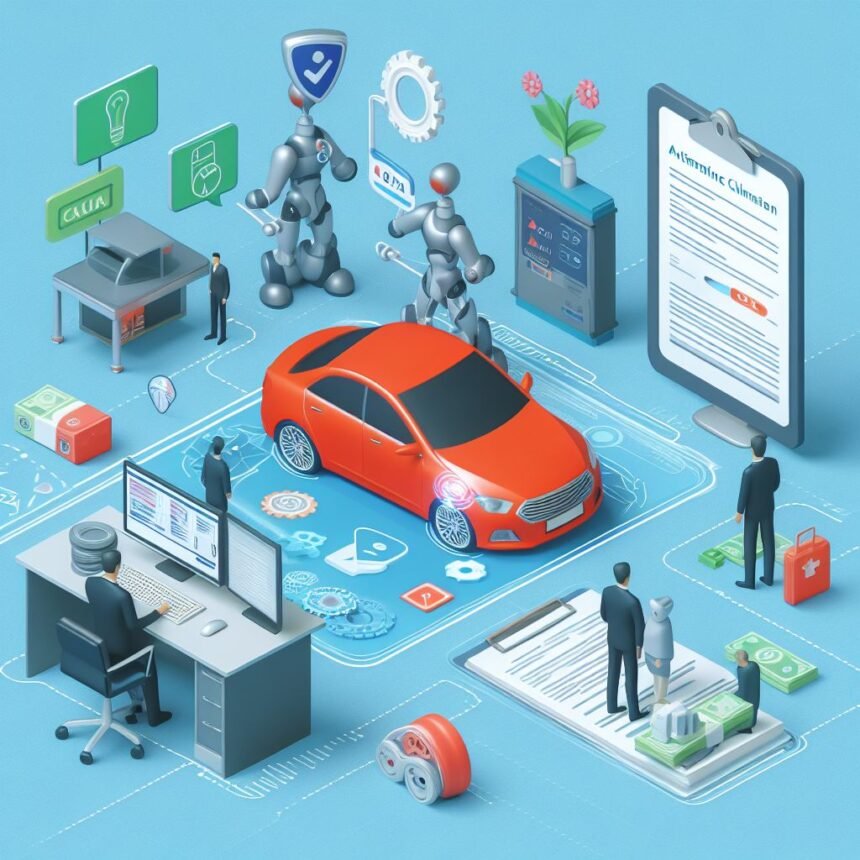Introduction to Claims Processing Automation
Claims processing automation represents a transformative advancement in the motor insurance industry, fundamentally altering how claims are managed from inception to resolution. At its core, claims processing automation leverages cutting-edge technologies such as artificial intelligence (AI), machine learning (ML), and advanced data analytics to streamline and expedite the claims handling process. Through the integration of these technologies, insurers can automate routine tasks, reduce manual intervention, and significantly enhance operational efficiency.
AI and ML play pivotal roles in claims processing automation by enabling systems to learn from historical data and improve over time. These technologies can identify patterns and anomalies, predict outcomes, and facilitate decision-making processes with minimal human oversight. Advanced data analytics, on the other hand, allows for the aggregation and analysis of vast amounts of data, providing actionable insights that can optimize the entire claims lifecycle.
The shift towards automation in claims processing is driven by several compelling factors. First and foremost is the need for enhanced efficiency. Traditional claims processing is often labor-intensive and time-consuming, leading to delays and increased costs. Automation addresses these issues by accelerating the process, thereby reducing turnaround times and operational expenses. Moreover, automation enhances accuracy by minimizing human errors that are common in manual processing, ensuring that claims are handled correctly and consistently.
Customer satisfaction is another significant driver behind the adoption of claims processing automation. In today’s fast-paced world, policyholders expect quick and seamless service. Automated systems can provide real-time updates, faster claim resolutions, and a more transparent process, all of which contribute to a better customer experience. Insurers that embrace automation can thus differentiate themselves in a competitive market by offering superior service and reliability.
In summary, claims processing automation is revolutionizing the motor insurance industry by leveraging AI, ML, and advanced data analytics to enhance efficiency, accuracy, and customer satisfaction. As the industry continues to evolve, the adoption of these technologies will likely become even more widespread, setting new standards for claims management.
Benefits of Automation in Claims Processing
Automation in claims processing has revolutionized the motor insurance sector, driving significant improvements in speed, efficiency, and accuracy. One of the primary advantages of claim processing automation is the dramatic reduction in processing time. Traditional manual methods often require extensive paperwork and human intervention, resulting in delays. In contrast, automated systems can quickly assess and settle claims, often within minutes, thereby enhancing overall efficiency.
Another notable benefit is the reduction of human error. Manual processing is prone to mistakes, which can lead to incorrect claim assessments and dissatisfied customers. Automation ensures a higher degree of accuracy by utilizing advanced algorithms and machine learning to analyze data. This precision not only minimizes errors but also ensures fair and consistent claim outcomes, enhancing trust between insurers and policyholders.
Cost savings are also a significant advantage of automating claims processing. By reducing the need for extensive human labor and streamlining operations, insurance companies can lower operational costs. These savings can then be passed on to customers in the form of reduced premiums, making motor insurance more affordable and competitive.
Enhanced customer experience is another critical benefit. Automated claims processing facilitates faster settlements, which is a crucial factor in customer satisfaction. A positive claims experience can lead to higher customer retention and loyalty. According to a McKinsey report, insurers that leverage automation can improve customer satisfaction by up to 30%, illustrating the profound impact on customer relations.
Real-world case studies further underscore these advantages. For instance, a leading motor insurance company implemented an automated claims processing system and reported a 50% reduction in processing time and a 40% decrease in operational costs within the first year. Such tangible benefits highlight the transformative potential of automation in the motor insurance industry.
In summary, automation in claims processing offers numerous benefits, including increased speed and efficiency, reduced human error, cost savings, and enhanced customer experience. These improvements not only streamline operations but also foster stronger relationships between insurers and their customers, ultimately driving growth and success in the competitive motor insurance market.
Challenges and Considerations in Implementing Automation
Implementing claim processing automation in motor insurance presents several challenges and considerations that need to be carefully managed to ensure a successful transition. One of the primary concerns is data security. Given the sensitive nature of the information involved in claims, robust cybersecurity measures must be in place to protect against breaches and unauthorized access. This includes encryption, secure data storage solutions, and regular security audits to ensure compliance with industry standards.
Another significant challenge is the integration of automation with existing systems. Many insurance companies operate on legacy systems that may not be fully compatible with modern automation technologies. Seamless integration requires a thorough evaluation of current infrastructure, potentially necessitating upgrades or complete overhauls to accommodate new software. This process can be resource-intensive and may require significant investments in both time and money.
The need for skilled personnel is also a critical consideration. While automation can handle routine tasks efficiently, there remains a necessity for human oversight to manage complex cases and exceptions that require nuanced judgment. This calls for a workforce that is not only proficient in traditional claim processing but also adept at leveraging new technologies. Continuous training and development programs are essential to equip employees with the necessary skills to work alongside automated systems effectively.
Regulatory compliance is another area that cannot be overlooked. The insurance industry is heavily regulated, and any automation efforts must align with existing legal frameworks. Companies must ensure that their automated processes adhere to guidelines set by regulatory bodies to avoid potential legal repercussions. This includes maintaining transparency in decision-making processes and ensuring that automated systems are auditable and accountable.
Finally, it is crucial to strike a balance between automation and the human touch. While automation can significantly enhance efficiency, it is imperative to maintain a level of empathy and personalized service in customer interactions. Automated systems should be designed to support, rather than replace, human agents, ensuring that customers receive the understanding and personalized attention they require during often stressful claim processes.
Future Trends and the Road Ahead
The landscape of motor insurance is on the brink of a transformative evolution, driven by advancements in claims processing automation. As we peer into the future, several emerging technologies stand out, holding the potential to further revolutionize the industry. Blockchain technology, for instance, promises to enhance transparency and security in claims processing. By creating immutable and verifiable records, blockchain can significantly reduce the risk of fraud and streamline the validation process, making the entire system more efficient and trustworthy.
The Internet of Things (IoT) is another game-changer in the motor insurance sector. IoT devices, such as telematics and connected car technologies, can provide real-time data on driving behavior, vehicle health, and accident circumstances. This wealth of data enables insurers to assess claims more accurately and swiftly, thereby improving customer satisfaction and operational efficiency. Furthermore, the integration of IoT with claims processing automation can lead to proactive risk management, where potential issues are identified and addressed before they escalate into claims.
Advanced Artificial Intelligence (AI) will continue to play a pivotal role in shaping the future of claims processing automation. AI-powered systems can analyze vast amounts of data to predict trends, detect anomalies, and provide personalized insurance solutions. Machine learning algorithms can learn from past claims to refine their decision-making processes, making them more accurate over time. This not only speeds up the claims process but also enhances the overall customer experience by providing faster resolutions.
Looking ahead, the evolution of automation in motor insurance is likely to give rise to new business models. Usage-based insurance (UBI), for instance, can leverage data from IoT devices to offer personalized premiums based on individual driving behavior. This shift towards more dynamic and data-driven insurance models will require insurance professionals to adapt and acquire new skills. Their roles may evolve from traditional claims handlers to data analysts and customer experience managers, focusing on leveraging technology to deliver better services.
To remain competitive, it is imperative for insurers to embrace these emerging technologies and innovate continuously. By staying ahead of the curve and investing in advanced claims processing automation, insurers can not only enhance efficiency but also deliver superior customer experiences, ultimately driving growth and success in the motor insurance industry.










